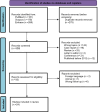End-colostomy parastomal hernia repair: a systematic review on laparoscopic and robotic approaches
- PMID: 38625435
- PMCID: PMC11249463
- DOI: 10.1007/s10029-024-03026-8
End-colostomy parastomal hernia repair: a systematic review on laparoscopic and robotic approaches
Abstract
Introduction: Parastomal hernia (PSH) is the most common and challenging complication after stoma creation, with an estimated 50% incidence 2 years after the index surgery. Mesh repair is the treatment of choice. Laparoscopic and/or robotic approaches allow acceptable outcomes.
Materials and methods: A systematic literature review from January 2012 to November 2023 was conducted according to the Preferred Reporting Items for Systematic Reviews and Meta-Analyses (PRISMA) statement. Embase, PubMed, and Scopus search were performed to select articles dealing with minimally invasive surgical treatment for PSH after end colostomy.
Results: 603 studies were found, and 24 were chosen. When compared to open surgery, laparoscopy showed decreased postoperative complications and recurrence. The main laparoscopic approaches are the keyhole (KH), the Sugarbaker (SB), and the sandwich technique. Continuous improvement in surgery, mesh technology, and surgeons' expertise led to an amelioration of surgical outcome and recurrence rate after repair. Recent studies showed comparable outcomes for SB and KH techniques, while novel surgical approaches have been proposed in an attempt to further increase the operative and long-term results. Reports on PSH robotic repairs are scarce and describe small series results, suggesting a role of the initial learning curve as a risk factor for complications.
Conclusion: End-colostomy PSH surgical repair still represents a challenge for surgeons. Recent evidence has not shown a significant advantage in postoperative complications and recurrence with a specific repair among SB, KH, and sandwich technique. The paucity of data on robotic surgery does not allow to draw definitive conclusion. Further primary, multicentric, and larger cohort studies are needed.
Keywords: Colostomy; Laparoscopic; Mininvasive surgery; Parastomal hernia; Robotic.
© 2024. The Author(s).
Conflict of interest statement
The authors have no competing interests to declare that are relevant to the content of this article.
References
Publication types
MeSH terms
LinkOut - more resources
Full Text Sources


